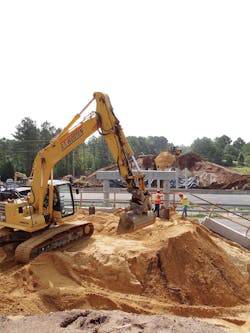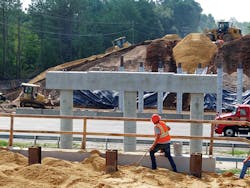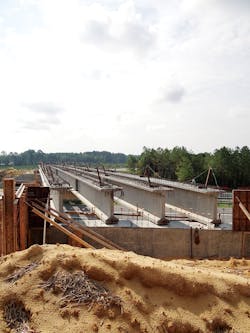Strategic planning and collaboration help keep I-95 road widening work in North Carolina on track
If you’ve driven through North Carolina on I-95 recently, you may have experienced some congestion between the cities of Fayetteville and Dunn. The 18-mile stretch of interstate has become notorious for heavy traffic due to the large volume of freight trucks and travelers traversing up and down the East Coast.
“Traffic is constant in this stretch, and it’s hard to predict when there might be a major disruption,” said Jason Salisbury, Division Construction Staff Engineer at the North Carolina Department of Transportation (NCDOT). “There could be an event two states away that causes a traffic jam in the area.”
This stretch of road was part of the first portion of I-95 built in North Carolina during the late 1950s and established as a four-lane, median-divided highway when it was completed in 1980. Now, it is the state’s busiest section with traffic volumes reaching nearly 60,000 vehicles a day. It serves as a major resource for commerce and tourism, in addition to supporting the hurricane evacuation route system for the region.
Recognizing that conditions would only worsen as traffic increases, NCDOT called on S.T. Wooten as the lead contractor to help design and build a more than $400 million road widening and bridge renovation project. For a section that has not had a major overhaul in fifty years, crews have had a lot of work cut out for them.
A winning strategy
S.T. Wooten is actively working with NCDOT to extend the I-95 section with two additional lanes in both directions, bringing it to eight total lanes between exits 55 and 72. NCDOT designed the northern 3-mile stretch of the project, and S.T. Wooten started that portion between fall 2019 and spring 2020. S.T. Wooten hired RK&K Engineering as their design firm and jointly laid out the remaining 15 miles of the project, which is currently under construction. The developments will bring a number of highly anticipated advancements to the area.
“The additional lanes will create more room for drivers on the road and help minimize traffic congestion,” said Salisbury. “Additional upgrades will be made to bring this older stretch up to more modern-day engineering standards.”
S.T. Wooten Project Manager Ronald Brock said the new design will offer accommodations that go beyond improving traffic on the highway.
“Crews are replacing the stop conditions at exit ramps with free-flowing roundabouts at some interchanges for smoother, safer traffic flow and to minimize the impact on nearby properties,” said Brock. “Bicycle and pedestrian lanes will be added across some overpasses for better community access.”
A total of 12 bridges are planned for construction or replacement as part of the project. Along with the installation of roundabouts to eliminate stop conditions at some interchanges, a new ramp will also be added to connect I-95 North to NC-295 South.
Beware of the caution flag
Since traffic management is the primary goal for the I-95 project, it is no surprise that the sheer volume also poses the most formidable challenge in construction. Crews have to work around tighter hauling and lane closure restrictions due to heavy traffic volumes throughout the day.
“There is a lot of night work happening to keep things moving along with less disruption for drivers,” said Salisbury. “Crews have also implemented some effective traffic management techniques to keep vehicles moving through the work zone and to avoid major shutdowns.”
For the longer stretch of the project, construction has been broken up into four major phases with traffic patterns transitioning to help manage drivers coming through the work zone. Traffic has been pushed to middle lanes in the early phases of the project, and then will transition to the outside lanes as things start to wrap up in the final stages of construction.
Safety is a top priority for crews, especially given the constant, high-volume traffic coming through this section each day. Large trucks are also an elevated source of distraction due to the amount of noise and wind they produce.
“We have our crews on extra-high alert with this project,” said Brock. “Keeping things organized around the work zone also helps us get in and out with the least amount of interaction with the driving public.”
ON TRACK DURING THE PANDEMIC
While traffic eased up slightly during the onset of the pandemic, it quickly returned to normal volumes. Other challenges, such as ongoing labor shortages, have posed more strategic obstacles for the team this past year.
“The labor shortage crisis is a reality that most organizations in the industry are facing right now,” said Brock. “You have to take it into account when you’re planning and try to anticipate other potential hurdles to ensure you don’t fall behind.”
Other factors coinciding with the pandemic have been long periods of wet weather and lengthier lead times for procuring materials. Thankfully, years of experience on major highway renovation projects have helped S.T. Wooten stay one step ahead.
“We put contingency plans in place for many of these factors this past winter,” said Brock. “We have been able to adjust efficiently with our schedule to avoid getting behind on the job.”
Thanks to strategic leadership and the reliability of crew members, S.T. Wooten’s team is currently on schedule without a major delay to date.
The smart race
Taking advantage of the latest in road construction technology, the I-95 project is designated as a smart work zone to help with traffic management. Digital sensors, monitoring cameras, speed limit signs, and message boards are set up along the stretch to help monitor traffic conditions. The information is tracked and routed back through the NCDOT Statewide Operations Center.
“The system helps us detect potential travel delays and alert drivers of alternate routes when necessary,” said Salisbury. “It also helps us spot incidents quickly and get the roads cleared quickly to minimize the impact on traffic.”
Salisbury said that the system has helped his team get tow truck crews to the site of an incident within 20 minutes to respond and get the roads cleared for drivers. Routine collaboration is helping everyone involved in incident management continue to improve on their collective response efforts.
“Every month, crews from S.T. Wooten converge with the NCDOT, highway patrol, and other emergency service teams to discuss our experiences,” said Brock. “It’s like a professional sports team coming together after a game to review the game film and try to keep on improving.”
A smooth turn
S.T. Wooten crews built some solid momentum on major project milestones this summer thanks to the warmer, drier weather. There are several big jobs that Brock and his team plan to finish off before the winter.
“We are doing a lot of paving work and hope to have several bridges completed by the end of the fall,” said Brock. “As crews make progress with these activities, we’ll be putting plans together for all the work that we need to get done next year.”
Helping in the planning process is the fact that S.T. Wooten and NCDOT have a lot of experience working together on state road construction projects. In fact, another major road widening job currently taking shape on I-40 in Raleigh shares many of the same characteristics and challenges.
“Experience matters, and we have leaders who are involved with both projects,” said Brock. “We’re able to share ideas, learn from each other’s capabilities, and use that intel to ensure we’re planning and working efficiently across both jobs.”
Collaboration will help crews stay on schedule with this expansive project. The ability to communicate and troubleshoot when unforeseen circumstances might arise—whether it is a bad storm or an accident along the highway—will help the team stay on track.
THE CHECKERED FLAG
The completion of this new I-95 stretch will be welcomed by many as an important part of the local, regional, state, and national transportation systems. The I-95 project is expected to be completed in 2024.
“The improvements will support many industries and countless people traveling up and down our state each day,” said Salisbury. “The benefits of this I-95 project will be felt by travelers for many years to come.”
S.T. Wooten expects to have several hundred construction workers on-site during peak periods of the project, including those from more than 20 subcontractors to help get the job done. And, while it is a milestone for the business in terms of size and scope, crews also take pride in the positive impact they are playing for the community and traveling public.
“Our team is really strong, and they’re proud to be a part of a job with this much of an impact,” said Brock. “It helps keep us motivated to work each day, and will help drive our teams forward until we reach the finish line.”





